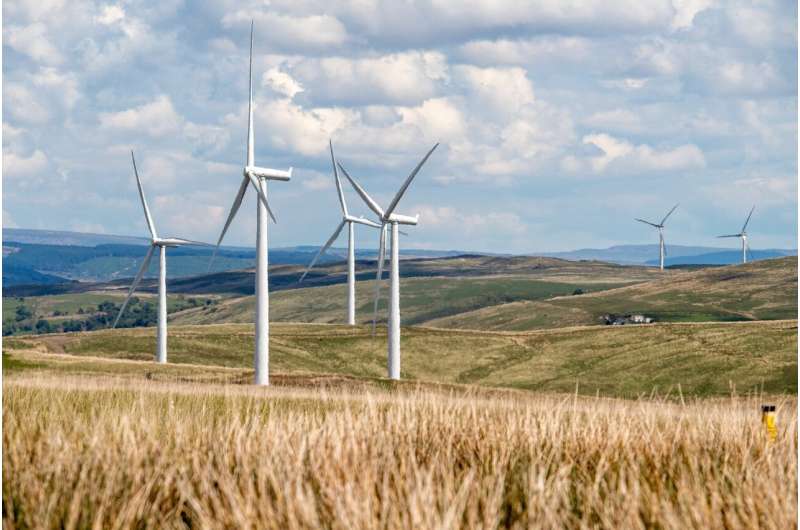This article has been reviewed according to Science X's editorial process and policies. Editors have highlighted the following attributes while ensuring the content's credibility:
fact-checked
trusted source
written by researcher(s)
proofread
Britain likely to generate more electricity from wind, solar and hydro than fossil fuels for the first year ever in 2023

There are many milestones to pass in the transition from a high to low-carbon sustainable energy system. There is the first hour without coal, or oil, or gas generation (or all of them together) and the point when the last coal, oil or gas power plant (or all of them together) are finally retired.
Another milestone that feels important is the first year when renewables generate more electricity than fossil fuels. For the past three months we have been tracking the data for Great Britain (not Northern Ireland, which shares an electricity grid with the Republic of Ireland) and we believe it is on track to pass this milestone in 2023, but it will be very close.
Using the broadest definition, renewables actually first overtook fossil fuels in the odd, COVID-affected year of 2020 (although not in the subsequent years of 2021 and 2022). However, that includes 5% or so of Britain's electricity that is generated through "biomass" plants (which burn wood pellets, often imported from forests in America).
Trees can of course be regrown, so biomass counts as renewable. But the industry has its critics and it's not globally scalable in the same way as the "weather-dependent" renewables: wind, solar and to a certain degree hydropower.
When we use this narrower, weather-dependent definition that is more appropriate for a global transition, then there is a very good chance these renewables will overtake fossil fuels for the first time ever in 2023. Once this milestone has been passed, we also think it is unlikely (though not impossible) that gas and coal will ever again generate more of Britain's electricity than wind, solar and hydro over a full year.
Whether Britain passes the milestone in 2023 will come down to the final few days of the year (from here on we'll use "renewables" to refer to the tighter, biomass-excluding definition).
The chart above can be used to track progress and will update with the latest data each day. The lines show the running total of the difference between how much electricity has been generated by renewables and fossil fuels.
When the line is increasing, this shows more renewables than fossil fuels for that period. The horizontal axis shows the day of the year, so, if at any point the line is above the zero axis, that indicates that the year so far has had more renewable than fossil fuel generation. If the red line ends the year above zero, then Britain will have achieved the milestone.
(One caveat is that we know from the official statistics published later that there are some differences from "missing" and estimates for embedded generation; this typically only accounts for around 1%-2% of the final total.)
It depends on the weather
As we write this, with ten days of data left in 2023, renewables are very slightly ahead (by just over 1,000 GWh—about the same level as a peak day of electrical demand). However if they are to stay ahead it will depend on the weather—especially the wind.
The reasoning here is that Britain uses less electricity over the holiday period due to less industrial and commercial demand. As wind power is clean and has become cheaper, it tends to be used first, meaning when demand is low or it is sufficiently windy there is less need to generate electricity with fossil fuels.
There are nuances around this such as where the generation is located, and the amount of electricity imported from other countries, but the general principle of renewables taking market share away from fossil fuels is a factor of Britain's electrical market.
An important area to also highlight is the continued drop in electrical demand. 2023 is on track to have a lower demand than 2022, which itself was lower than the COVID-impacted year of 2020 (against our predictions) due to record prices. The drop in electrical demand means that additional generation was not needed, much of it inevitably from fossil fuels.
Additional milestone also likely to be passed
However 2023 could be the first year where renewable generation exceeds domestic electricity demand (homes comprise 36% of total electrical demand). This means the annual electricity generated by Britain's wind turbines, solar panels and hydro resource will now be greater than that consumed over the year by its 29 million households.
The above bar chart demonstrates the trend towards this point since 2009. In the first half of 2023, renewable output was less than domestic electrical demand by 1.5 TWh (1500 GWh), but strong renewable performance since then means it is likely to end the year with total generation in excess of household demand.
If either of the milestones described here do not happen for 2023, then they will almost certainly occur in 2024, during which another 1.7 GW of offshore wind capacity will begin generating and Britain's last coal-fired power station is scheduled to cease producing electricity altogether.
This article is republished from The Conversation under a Creative Commons license. Read the original article.![]()


















